
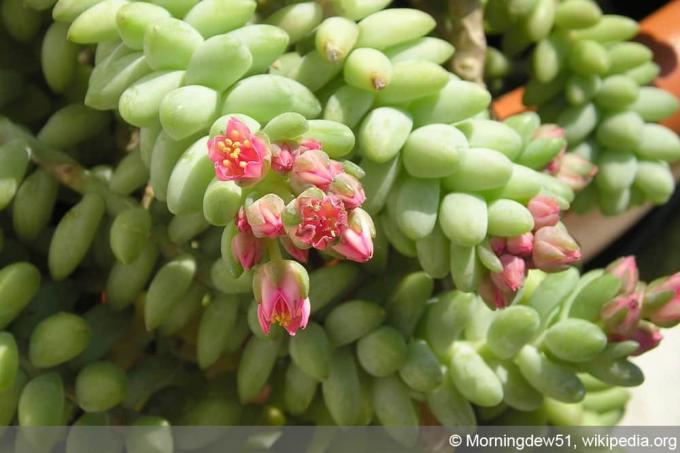
Table of contents
- General care and information
- Location
- substrate and soil
- use
- Pour
- Fertilize
- pests/diseases
- Cut
- multiply
- hibernate
- frequently asked Questions
- Worth knowing about the snake sedum shortly
Succulents, as thick-leaf plants are also known, have this name because of their leaves that are bulging with water. The ability to store water is vital for these plants. They originally come from dry areas or regions where rainfall varies greatly. The snake sedum is one of the few plants of this genus that also feels at home in the room. It originally comes from Mexico and is also known as a monkey swing, roller sedum or monkey tail.
General care and information
The succulent family includes about 400 to 750 species of different plants. Few of them are suitable as domestic houseplants. The Sedum morganianum has long shoots and leaves about two centimeters long and one centimeter thick. These have a light gray color and whitish tires. The leaves fall off easily, so the plant needs careful handling. The perennials reach a height of up to 30 centimeters, the growth width is between 10 and 30 cm. The evergreen Sedum morganianum has entire and long-tealed leaves, which have a hairy, soft surface. The flowering period is from April to July, when the sedum plant bears red to dark red wheel-shaped flowers.
Tip:
The flowers of the plant are very decorative. The Sedum morganianum makes a very good traffic light plant due to its shoots, which can be up to one meter long.
Location
The Sedum morganianum, so the Latin name, is a popular plant for the room window. She likes a full sunny spot. In contrast to other indoor plants, which wither away in dry room air, the snake sedum feels really good in such a climate. In summer, the traffic light can also get a sunny spot on the terrace or on the balcony. In winter, however, when there is little light, the plant prefers a cooler place, 5 to 10 °C is then good.
Tip:
Caution is advised with sharp-edged traffic light pots, there is a risk that the shoots will snap off.
substrate and soil
The optimal soil should be loamy and preferably interspersed with small pebbles so that no water can accumulate. Cactus soil is also very suitable as a substrate. The perennials like fresh to moist soil, good ventilation should be provided in summer.
use
In addition to being used in hanging baskets, the Sedum morganianum is also suitable as a pot and house plant. A temperature-controlled greenhouse is suitable for cultivation, year-round outdoor cultivation is possible, but only at temperatures above -5 °C.
Pour
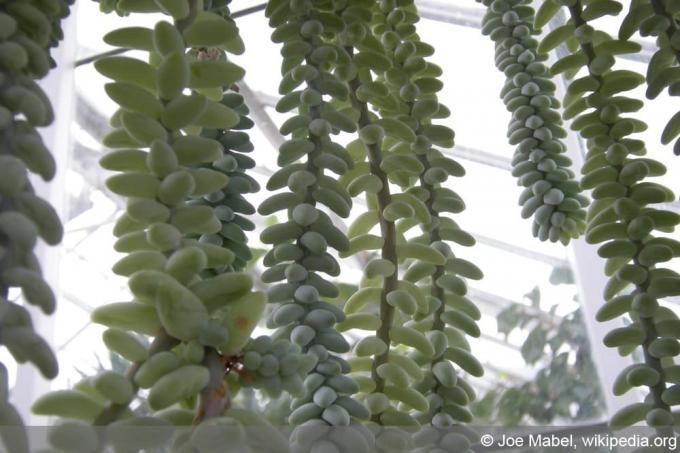
The snake sedum is used to drought, too much watering and watering inevitably means the end of the plant. There should be no waterlogging and the soil should always dry well between watering. Ideally, the soil should dry out properly from time to time. Between March and October, the growth period, the sedum plant should only be watered with a little water once a week. From November to March only enough moisture should be given to prevent the leaves from shriveling. If you go on vacation, you don't need to worry about this succulent. she can get by on her own for a good few weeks. The shoots shimmer silver-green and grow without you having to do anything. During flowering, the snake sedum also produces pink or purple flowers.
Fertilize
In the growth phase, the snake sedum can also tolerate some cactus fertilizer when watered for a week. In the dormant phase from November to March, it should not be fertilized at all.
pests/diseases
The Sedum morganianum is hardly susceptible to pests and diseases, even voracious slugs avoid the Sedum morganianum. Too much watering and stagnant water causes root rot. If honeydew and waxy threads appear on the sprouts and leaves, this indicates mealybugs. Ladybug larvae or insecticides can help. If the sedum turns pale green or suddenly appears with wilted spots, this is a sign of fungal infestation. The affected parts must be removed. If scaly insects appear on the undersides of the leaves and sprouts, these are scale insects. These are also combated with beneficial insects or insecticides.
Cut
Cutting back the snake sedum is not absolutely necessary. If the shoots are bare after a few years and no longer look nice, they can be rejuvenated by pruning. This is ideally done in the spring before they sprout again. A freshly sharpened and, if possible, disinfected knife should be used to cut the shoots. Alternatively, sharp scissors can be used to cut the shoots at the base.
multiply
The plant is easy to propagate and generally requires little maintenance. Sowing can be done in autumn in a cold frame, propagation by cuttings in early summer. Propagation is possible either by cuttings or from individual leaves, which form roots. The interfaces should dry two days before the offshoots come into a cultivation substrate that is moderately moist.
hibernate
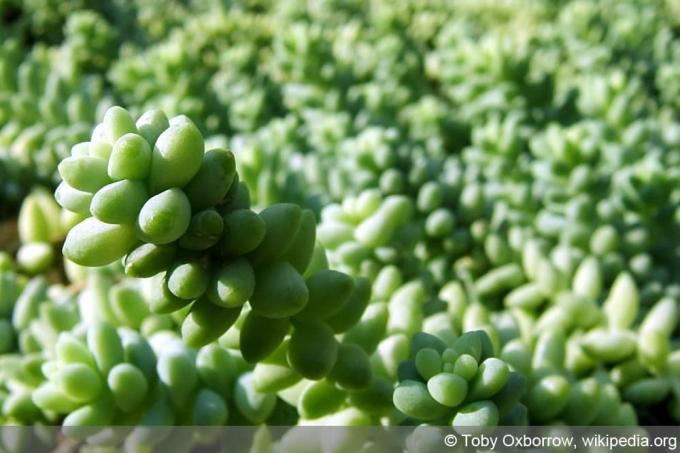
In winter, the snake sedum needs even less water. It tolerates temperatures down to -7 °C. It overwinters best in a well-ventilated room or a greenhouse. Their ideal growth is at temperatures between 18 and 24 °C.
frequently asked Questions
Yes, but you should make sure that there is no waterlogging. Otherwise enrich the soil with gravel, sand, perlite or lava dust. The same applies to the planting of flower boxes and tubs.
Various methods are available for the propagation of Sedum morganianum. On the one hand, propagation by cuttings, by sowing or division.
Best shortly after sprouting in spring. These are cut off in a length of four to 5 cm. Briefly immerse the interfaces in hot water or leave to dry for a day. Then put them in the seed pot, after four to six weeks the young plants can be planted at their destination.
The soil is probably too nutrient-rich, the shoots that lie on the ground are particularly affected. No fertilizer should get into the sedum, the nutrient content of the soil must be reduced by incorporating gravel, sand and grit.
Worth knowing about the snake sedum shortly
botany
- The snake sedum belongs to the genus of sedum, which is also called stonecrop.
- This genus of plants includes about 420 species that are found almost all over the world.
- They often come from very hot regions where they don't mind the drought because they have the ability to store water in their leaves.
- In the meantime, many different varieties of sedum can be found in German gardens.
- However, some species can also be used very well as houseplants, including the snake sedum plant.
- The snake sedum is colloquially called the monkey swing because of its appearance.
Care
- The snake sedum plant, with the botanical name Sedum morganianum, prefers a sunny spot with direct sun.
- There she should hang quietly as a traffic light plant, because her leaves fall off very quickly when touched.
- In order to support flowering in winter, the plant should overwinter in a cool room at 5 to 10°C.
- The monkey swing can be easily propagated by sticking leaves or shoots into dry plant substrate.
- However, cut shoots should be dried for a few days beforehand.
Pour
- Because of its origin, the monkey swing requires very little water, so it should be watered very sparingly.
- Very little water is less of a problem for the plant than too much, so the soil can dry out before the next watering.
- The plant can easily survive a long period of time without water because its leaves serve as storage.
- During the winter months, the amount of water should be reduced again.
- In addition, no water should remain in the pot of the plant.
 garden editorial
garden editorial I write about everything that interests me in my garden.
Find out more about perennial lexicon

Lenten rose, Helleborus orientalis: 13 tips for care
The spring rose is one of the few plants that also blooms in winter. In order for the plant to bear its colorful flowers, however, certain requirements regarding location and care must be met.
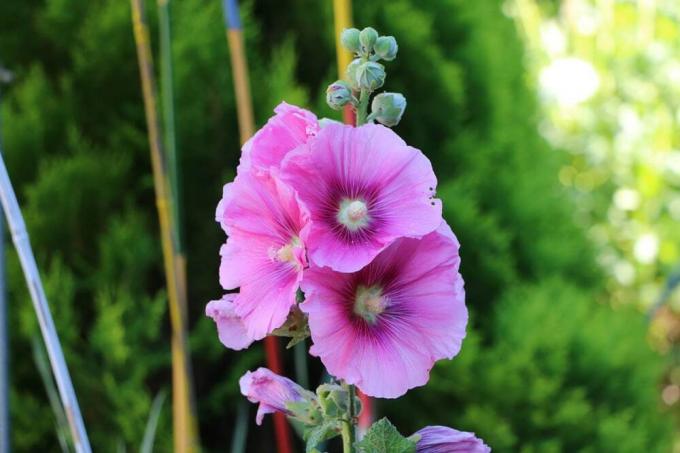
13 hardy perennials for sunny locations
Hardy perennials have a particularly long lifespan and allow sunny locations to bloom beautifully. At the beginning of each season, the perennial plants thrive anew and enchant the garden with a colorful world of flowers. Due to the large number of varieties, you have many design options.

Tree peony, Paeonia suffruticosa: Care from A - Z
With its large, eye-catching and colorful flowers, it is one of the noblest representatives of the peonies, the tree peony. Its natural home is China, which is why it is often referred to as the imperial flower. It presents its beautiful flowers between April and June.

Fat man: Care from A-Z | Planting distance and propagation
The shady areas under trees are neglected in many gardens, because only a few plants feel comfortable here. One of these few plants is the fat man (bot. Pachysander terminalis).
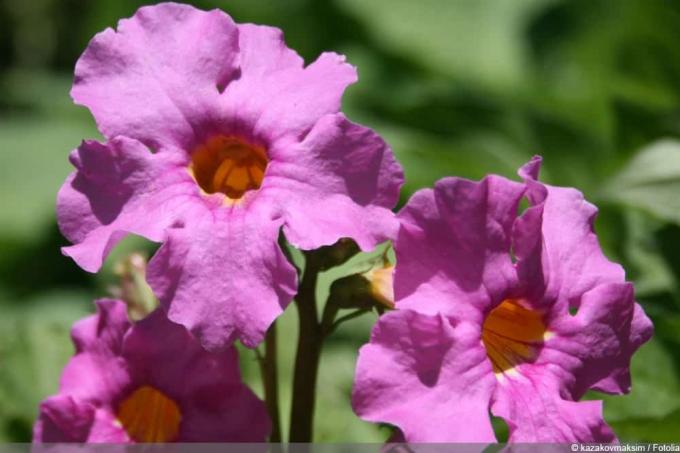
Flowering Fern: 14 Annual and Hardy Species | Care Instructions
A green fern with its beautifully designed fronds is a feast for the eyes in itself. It doesn't have to bloom to inspire. If flowers do appear, a garden gloxinia is actually at work. This flower is often incorrectly referred to as a blooming fern.
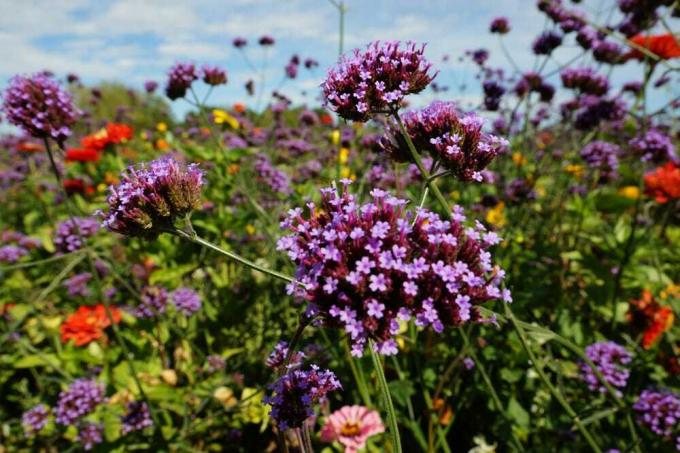
Patagonian Verbena, Verbena Bonariensis - Care Guide
Summer, sun, garden, flowers - here the Patagonian verbena is in its element, with fairy-like lightness purple flowers float on filigree stems above the flower bed and also attract all the butterflies area. Romantic gardeners love the effect of Verbena bonariensis, every gardener loves it Vigorous growth with the lowest maintenance requirements - verbena is a herb that benefits every garden brings.
